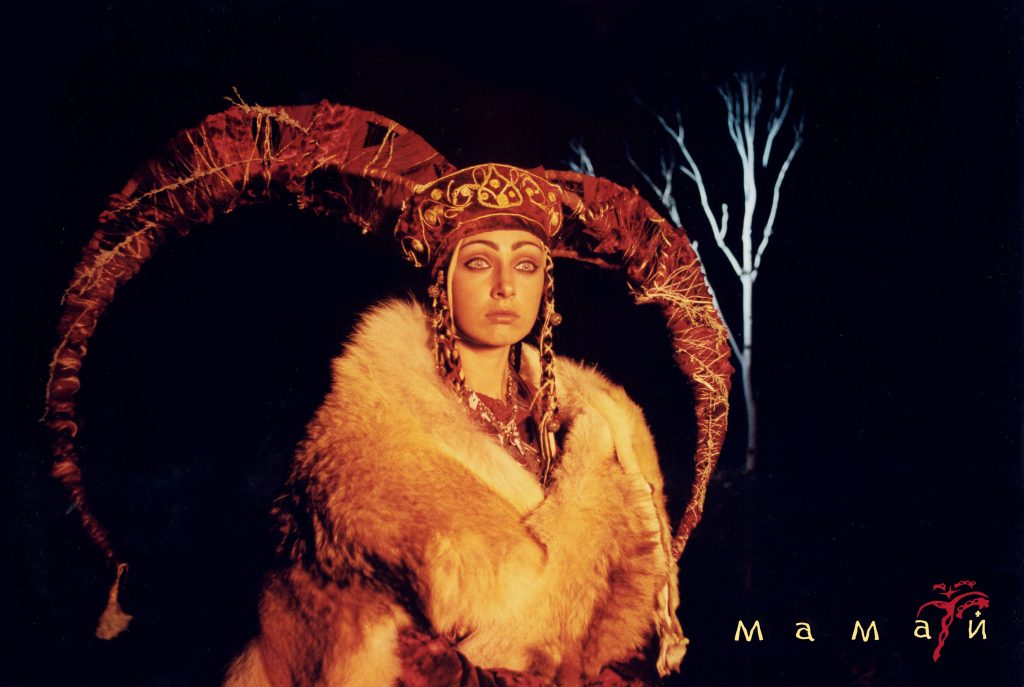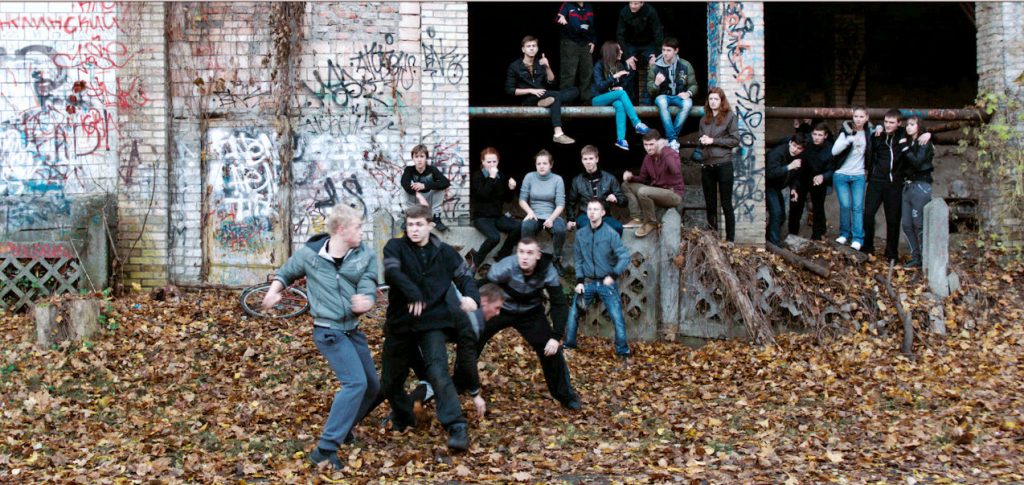Like the country itself, Ukrainian cinema has gone through periods of stagnation in the 1990s and creative search in the 2000s, as well as a remarkable revitalisation after the Euromaidan revolution of 2014. Throughout the years of independence, Ukrainian filmmakers approached the question of national and cultural identity in diverse and surprising ways. Vitaly Chernetsky surveys the films of the last three decades and draws attention to the linguistic and stylistic choices which have shaped Ukrainian identity on screen.
A ‘lost generation’ of filmmakers
The history of Ukrainian cinema has witnessed many dramatic twists and turns over the past thirty years. Ukraine, like elsewhere in the former Soviet bloc, saw a cultural reawakening in the end of the 1980s and beginning of the 1990s thanks to the opening up of society. Censorship was finally abolished, many banned and shelved Soviet-era films at last reached audiences, and a flurry of ambitious new projects were produced, tackling challenging topics ranging from the dark pages of Soviet history to contemporary social issues. However, this wave quickly crashed under the pressures of the economic crisis of the 1990s: most of the cinemas closed and those that stayed open focused almost exclusively on showing Hollywood films. Even the newly-made films that did get made no longer had a clear path to reaching audiences.
Nevertheless, as in previous periods, a host of new talented filmmakers debuted during this time. Their films, often bold and innovative both aesthetically and thematically, ran into trouble with distribution. The filmmaking and film screening industry became entirely separate from one another. Film scholars thus talk of a decade of ‘hidden films’ and of a ‘lost generation’ of filmmakers. These young talents often switched to other occupations (for instance, making TV adverts) or tried their luck in other countries. Some of their work is only now getting the attention and appreciation it deserves.
For all their risk-taking and innovation, however, the films that did get released in the 1990s, whether by seasoned auteurs or young upstarts, did not exhibit a consistent, thoughtful approach to questions of identity and language. A large percentage of them seemed unsure whether they were generically ‘post-Soviet’ or specifically Ukrainian. In a telling gesture, when A Friend of the Deceased, directed by Viacheslav Kryshtofovych, was released internationally in 1997, becoming Ukraine’s biggest cinematic success of the decade, both Ukrainian-language and Russian-language soundtrack versions were produced. However, the version shown abroad, combined with subtitles in the local languages, used the Russian-language soundtrack. In other words, Ukrainian film industry leaders were confused about the linguistic practices they wanted to present both to domestic and international audiences, and this confusion inadvertently contributed to the prejudicial view that there was little, if any, meaningful difference between Ukrainian and Russian culture – at least as far as cinema was concerned.
Economic precarity, cultural endurance, poetic cinema
By the early 2000s, as the country began to emerge from the economic crisis, new energies also started bubbling in the film industry, just as the Orange Revolution of 2004 galvanised civil society and brought worldwide attention to Ukraine. An early harbinger of the revival was the 2003 film Mamay, Ukraine’s first submission to the Oscars, directed by Oles Sanin. The film represents arguably the most successful return to the poetic cinema aesthetic in post-Soviet Ukrainian cinema, creating a visually stunning meditation on the arid landscapes of southern Ukraine as well as on images from traditional folkloric poetry and visual art. The film champions the coexistence and interaction between the Ukrainian and Crimean Tatar peoples and cultures in the pre-modern era, and the two different languages spoken, Ukrainian and Crimean Tatar, emerge not as a barrier for communication but as a symbol of cultural endurance in precarious circumstances – a leitmotif of both Ukrainian and Crimean Tatar histories.

Within the mini-boom in Ukrainian cinema after the Orange Revolution of 2004, a few films stand out. Orange Sky, directed by Oleksandr Kyriienko, and OrANGELove, directed by Alan Badoev, both released in 2006, are very different from each other aesthetically. Yet, both films have at their centre a relationship between a Ukrainian-speaking woman and a Russian-speaking man. As scholars have argued, the language use of Orange Sky in particular is laden with heavy-handed symbolism: Russian speakers are depicted as realistic and well-grounded, while the Ukrainian language is associated with idealism and fantasy. One might also place A Melody for the Barrel Organ (2009) by Kira Muratova (1934–2018), the internationally acclaimed Ukrainian filmmaker, within the post-Orange Revolution ‘mini-wave’. This film, an unflinching exposé of the casual cruelty one observes in contemporary urban life, is also Muratova’s work that showcases the greatest sensitivity to linguistic diversity; while the Russian language still predominates in it, as in her other films, several characters are Ukrainian-speaking, and their role in the narrative is to burst the bubble of false respectability and deliver a metaphysical breakthrough.
Films of the revolution
Gradually, a new generation of Ukrainian filmmakers began to gain recognition, with a number of Ukrainian films receiving attention and prizes at major international film festivals, primarily in the short film sections. A true revival finally came as a response to the Revolution of Dignity in Kyiv in the winter of 2013–14 (a.k.a. the Euromaidan) and the subsequent Russian aggression in Crimea and the Donbas region. These dramatic events led to a rush to document changes in Ukrainian society, resulting in dozens of documentary projects. Perhaps of greatest relevance to the documentation of Ukraine’s language diversity is the acclaimed and award-winning BABYLON’13 project, the work of a filmmakers’ collective established in 2013, in the early days of the Euromaidan protests. Among its informal leaders is the director Volodymyr Tykhyi. The collective’s output has resulted in a multitude of films – some as short as 20 seconds, others full-length features – which reflect the messy diversity of Ukraine in the midst of momentous transformations.
It was a fictional full-length feature shot during the Euromaidan events, Myroslav Slaboshpytskyi’s The Tribe (2014), that made clear to the global film community that exciting changes were afoot in Ukrainian cinema. Shot entirely in sign language, with no spoken dialogue, no non-diegetic sounds, and no subtitling for hearing audiences, Slaboshpytskyi’s film was a game-changer. In a way, it manifested a return to experiments with ‘pure cinema’ during the golden age of silent film, like Dziga Vertov’s Man with a Movie Camera (1929), also produced in Ukraine. The Tribe won over thirty festival awards and became the greatest international success of the Ukrainian film industry to date. Its long-term effect within Ukrainian filmmaking has been a liberatory gesture, a licence to approach questions of identity, including language identity, in novel, non-traditional ways.

Blossoming of new Ukrainian cinema
The last eight years have witnessed a remarkable blossoming of new Ukrainian cinema across a wide spectrum of genres, pursued by filmmakers of all generations (but with young filmmakers being particularly active). It is impossible to do them all justice within the space of a short article. However, several trends stand out. One is the series of breakthroughs in documentary cinema, of which the most famous is Iryna Tsilyk’s The Earth Is Blue Like an Orange (2020), the winner of the World Cinema Documentary Directing Award at Sundance and of more than a dozen other prizes. Set in a small town near the front line in the ongoing war against Russia-backed separatists, the film focuses on the story of one family and the ingenious ways its members cope with the challenges of the conflict. This work is part of a larger wave of diverse films exploring the war, ranging in style from sombre dramas and action films (Timur Yashchenko’s Cherkasy, 2019; Akhtem Seitablaev’s Cyborgs, 2017), to absurdist exposés of the often-surreal turns of events within and around the conflict (Sergei Loznitsa’s Donbas, 2018; Natalia Vorozhbyt’s Bad Roads, 2020), to attempts to grapple with future post-conflict traumas (Valentyn Vasianovych’s Atlantis, 2019). Another promising trend is films focused on young people and their problems that speak powerfully to audiences across national boundaries, including two recent award winners in the 14+ category at the Berlin Film Festival, School no. 3 (2017) by Elizaveta Smith and Georg Genoux and Stop, Earth! (2021) by Kateryna Gornostai.

Among other notable tendencies are dramedies that explore the contradictions of contemporary Ukrainian society, such as Roman Bondarchuk’s Volcano (2018) and Antonio Lukich’s My Thoughts Are Silent (2019), as well as adaptations of works by contemporary Ukrainian writers, especially Yaroslav Lodygin’s The Wild Fields (2018), based on Serhiy Zhadan’s novel Voroshilovgrad (2010), and Khrystyna Syvolap’s Viddana (Devoted, 2020), based on Sophia Andrukhovych’s Felix Austria (2014). But there are also historical dramas, romantic comedies, and even boldly alternative musicals, like Olena Demyanenko’s Hutsulka Ksenya (2019). An important trend also focuses, in the context of the trauma of Russia’s annexation of Crimea, on Crimean Tatar history and present, with several standout films, in particular, Nariman Aliev’s Evge (Homeward, 2019).
With recent successes at the world’s leading film festivals, from Venice to Sundance, Ukrainian cinema today can thus be seen as beginning to receive the international attention it deserves. Alongside exciting new productions, restorations of both classic and unjustly forgotten films, especially those from the silent era, are also attracting film buffs worldwide. Step into and explore the rich and rewarding world of Ukrainian cinema.
Vitaly Chernetsky is a Professor in the Department of Slavic and Eurasian Languages and Literatures at the University of Kansas. His research focuses on modern and contemporary cultures (literature, film, popular culture) of Russia, Ukraine, Central and Eastern Europe, and Central Asia, considered in broader comparative/cross-regional and interdisciplinary contexts. Chernetsky is the author of the book Mapping Postcommunist Cultures: Russia and Ukraine in the Context of Globalization, of five edited or co-edited volumes, and numerous articles and reviews. His published translations from Ukrainian and Russian into English include two novels and numerous shorter literary works, as well as scholarly articles and historical documents.
Image: Still from Atlantis (2019), dir. Valentyn Vasyanovych.
Become a supporter and help us publish future issues of the London Ukrainian Review.
